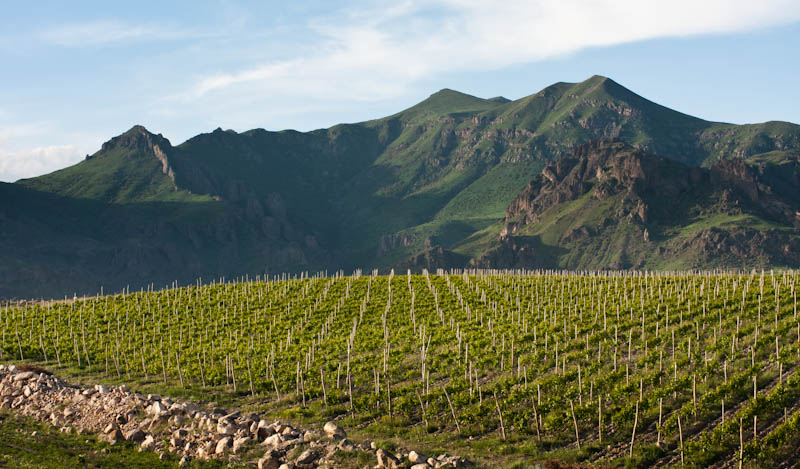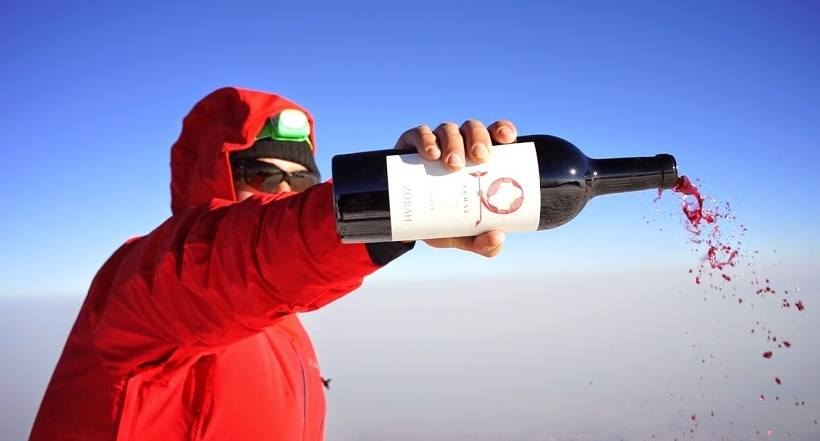
So, to start this story we have to go back a little in time. Like, 6,000 years. That’s when the world’s oldest wine cellar was built in the part of the world that begat Zorah. The biblical terroir is something to behold, and the tagline for the top cuvée is “vines older than time”. Indeed the Areni Noir grape it’s made from – indigenous to this part of Armenia – grows on low-yielding bush vines in semi-abandoned sites planted well over 100 years ago, in a landscape as raw and remote as you’ll see.
But we’re not here for a lecture on geography or history. We’re here to talk about wine. We kicked off with Zorah a year ago armed with the 2013 Karasì Areni Noir, a wine summed up by Jancis Robinson’s sidekick Julia Harding MW as boasting “lovely, fresh dark-red fruit. Peppery, dry and crisp. Fine, elegant, dry paper-fine tannins… Elegant, long and with a delicate finish.” Yes, the wine’s pedigree matches its provenance. In Italy’s Alberto Antonini, it counts as its creator one of the finest winemakers on the planet.
The dream of growing wine that embodies this place was what drove Zorah founder Zorik Gharibian to the small rural village of Rind in the heart of Yeghegnadzor, Armenia’s top grape-growing region. An Armenian who studied in Venice and Milan before embarking on a successful fashion career, Zorik began pouring his heart and soul into this in the 2000s. He planted a 40-hectare, ungrafted vineyard on rocky, limestone-rich soils vineyards in the land of his forefathers, surrounded by dramatic snow-capped mountains, 1,400m above sea level. The region enjoys long, dry summers, with remarkably vivid sunlight and high daytime temperatures contrasting with cool nights. The lengthy growing season lasts to the end of October.
Karasì was the estate’s first wine. It is a brilliant introduction to amphora-aged Areni Noir, this elegant, fresh, thick-skinned and disease-resistant variety that has adapted through the ages to the high altitudes and extreme temperatures variations. Now’s the turn of the 2014 Karasì.
This is joined by the estate’s first white wine, Voskì. This blend of the local varieties Voskèat and Garandmak reminds Julia Harding MW of a Rhône white with higher natural acidity, with hints of apple, citrus and stone fruits. Derek Smedley MW hailed its “fresh, lean, long and mineral” finish.
The pinnacle of the range – a tremendous wine fittingly and memorably launched at the top of Mount Ararat – is the 2012 Yeraz. The site is a little higher up, at 1,600m, and these are the centenarian vines from which cuttings were taken to plant the more recent vineyards.
 2014 Zorah ‘Voskì’ Voskèat Garandmak RRP $62
2014 Zorah ‘Voskì’ Voskèat Garandmak RRP $62
Ancient indigenous varieties, archaeological evidence suggests that both Voskèat and Garandmak have been present in Armenia for millennia. Voskèat translates as “golden seed” and is considered queen of Armenia’s grapes. It’s a delicate, gold-coloured grape with small, compact, relatively thin-skinned berries and bunches in the shape of a cross. Garandmak means “fat tail” and is one of the most popular grapes. It’s a hardier variety, greenish yellow in colour, with larger, thicker-skinned berries and compact bunches.
Although both varieties are present throughout Armenia’s territory, the exceptional terroir here yields distinctively balanced fruit. The grapes for Voskì are sourced from old vineyards at altitudes of 1,400m from vines grown on original, ungrafted roots.
The musts are fermented with indigenous yeasts in large, temperature-controlled concrete vats which are left rough deliberately to favour micro-oxygenation. Ageing then continues in concrete vats for eleven months with a further six months in bottle. Concrete is preferred to stainless steel as it allows the wine to breath over the maturation period.
50% Voskèat, 50% Garandmak. Fermented and aged in concrete tanks. Fermented with ambient yeast. No malo. pH 3.25, TA 6.4 g/l, RS 2 g/l. According to winemaker Alberto Antonini, the Voskèat tends to give stone-fruit flavours, the Garandmak brings freshness, and this does have a creamy stone-fruits aroma. Although there is a breadth to the flavours on the palate, it is still crisp and fresh, reminding me a little of a Rhône white but with higher acidity. 17/20 Julia Harding MW, jancisrobinson.com November 2015
Bright and fresh, the nose has a mineral crispness, the palate a mix of fruits green apple backed by citrus. A hint of sweetness at the back adds complexity but it finishes fresh, lean, long and mineral. 92 points. Derek Smedley MW January 2016
2014 Zorah ‘Karasì’ Areni Noir RRP $62
MAGNUM RRP $128
Again, this is from vineyards at altitudes of 1,400m on phylloxera-free terroir with low-vigour, sub-alkaline sandy soil, rich in limestone and large stones. The cuttings of the vines come from ancient abandoned vineyards of a nearby 13th century monastery.
Stainless steel tanks have given way to temperature-controlled, rough concrete vats in which the musts are fermented with indigenous yeast. The micro-oxygenation in the concrete is similar to that of the traditional clay amphorae ‘karas’ in which the wine is then aged for around twelve months. The karas used are of varying sizes. Some are buried in the ground while others are above ground, each giving their own unique nuances to the wine they contain. After very light filtration the wine is aged for a further six months in bottle.
Red fruited freshness a mix of fragrances the nose is bright the start of the palate quite light. Richer and sweeter in the middle ripe mulberry backed by bramble complexity at the back there is an exotic spicy charm. 92 points. Derek Smedley MW January 2016
2012 Zorah ‘Yeraz’ Areni Noir RRP $250
This fabulous wine is the top cuvée from Zorah, and 2012 is its inaugural release. Yeraz fittingly means “dream” in Armenian, as well as being the name of the wife of Zorah’s founder, Zorik Gharibian. It represents the dream of reviving an ancient wine culture and rediscovering forgotten native grapes.
The pinnacle of high-altitude viticulture, the grapes for Yeraz come from semi-abandoned bush vineyards planted well over a hundred years ago at altitudes of 1,600m above sea level. Raw and remote, these vines reflect the resilient and tenacious spirit of this land and its people.
Fermentation occurs in rough concrete tanks using natural yeast. Drawing inspiration from ancient local traditions, Yeraz is then aged for a prolonged period in local amphorae of varying sizes, some of which are dug deep in the ground and sealed with wax to conserve the intense flavours and varietal purity of the wine. In addition to the amphorae, large untoasted casks are also used to soften the tannins. After very light filtration the wine spends a further year in bottle.
First vintage of this wine. This wine is made from the small parcel of centenarian vines from which cuttings were taken to plant the more recent vineyards. Fermented in unlined concrete tanks and aged in a mix of concrete tanks, very large untoasted casks and traditional, partially buried Armenian amphorae. A little less expressive than the Karasí 2012 but it has wonderful depths and great length and still that fresh peppery quality of this variety. The fruit is sweet and lightly herbal. More juicy at this stage than the 2013 Yeraz but the overall balance of the 2013 shows the superiority of that vintage. This is a glorious combination of an expressive variety and a great site, with the winemaking subtle enough to let both shine. 18/20 Julia Harding MW, jancisrobinson.com November 2015
There is a lot happening on the nose the palate has layers of flavour with black fruits tending to dominate. Mid freshness bramble but the fruit at the back is sweet and ripe the finish has depth and richness. There is all the complexity that old vines can give. 93 points. Derek Smedley MW January 2016
